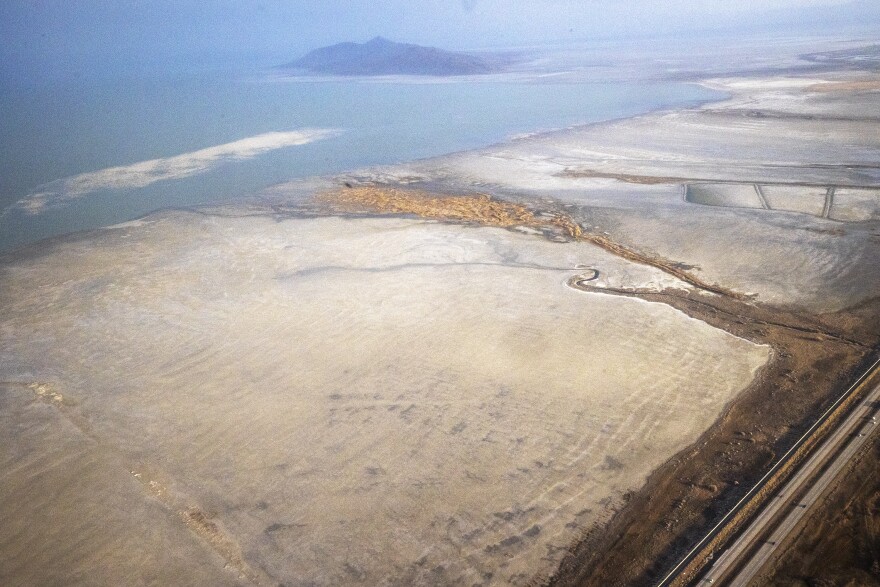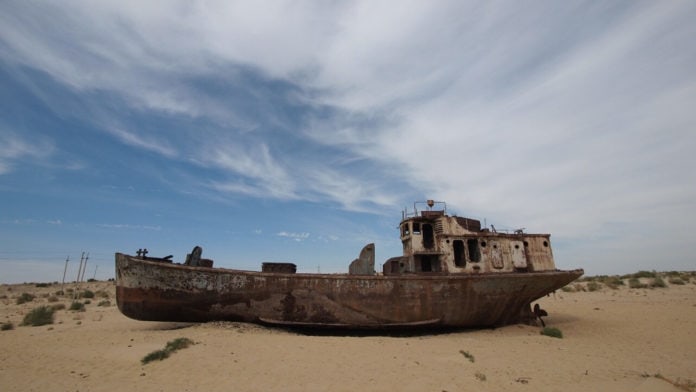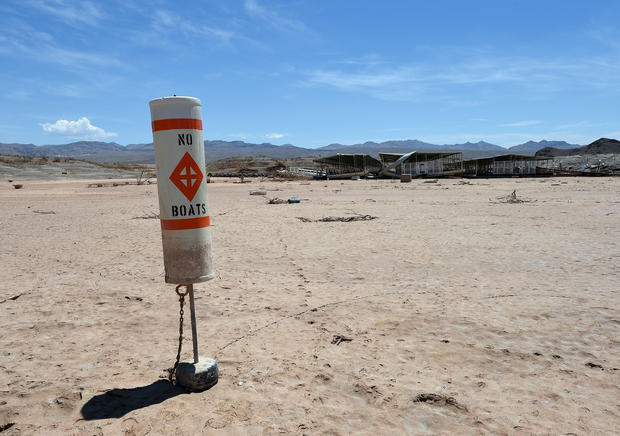
If we can’t save one lake, how will we save the planet?
We all think we know why it’s so hard to motivate our fellow Americans to meet the threat of climate change:
- The danger seems distant, as if we still had a lot of time to react.
- The problem seems abstract: So what if statisticians claim the average day is a degree or two warmer than it would have been a few decades ago? Why is that such a big deal? Maybe the computer models are wrong and the projections of disaster are just scaremongering.
- Such disasters as we’re already seeing — hurricanes, droughts, fires, heat waves — don’t come clearly marked “brought to you by climate change”. Similar things have happened in the past, so maybe these would have happened anyway.
- Because climate change is global, it’s hard to connect our own actions to the outcome. If we make sacrifices, but the Chinese and Indians don’t, they’ll get an advantage on us and all the bad things will happen anyway. As Marco Rubio put it when he was running for president in 2015: “America is not a planet.“
But what if we faced an environmental disaster where none of those factors came into play? Something entirely within our borders, where the changes were visible to the naked eye, and the looming catastrophe obvious. Something clearly connected to current policies, and addressable by changing those policies.
We’d be all over that, wouldn’t we?
Well, apparently not.
Not quite two weeks ago, the New York Times reported that a combination of climate change, over-population, and profligate water use is killing the Great Salt Lake.
Last summer, the water level in the Great Salt Lake reached its lowest point on record, and it’s likely to fall further this year. The lake’s surface area, which covered about 3,300 square miles in the late 1980s, has since shrunk to less than 1,000, according to the U.S. Geological Survey.
The salt content in the part of the lake closest to Salt Lake City used to fluctuate between 9-12%, according to Bonnie Baxter, a biology professor at Westminster College. But as the water in the lake drops, its salt content has increased. If it reaches 17% — something Baxter says will happen this summer — the algae in the water will struggle, threatening the brine shrimp that consume it.
Algae and brine shrimp are the bottom of a food chain. Migratory birds who rely on the lake as a resting spot in their otherwise perilous desert crossing would go next.
While the ecosystem hasn’t collapsed yet, Baxter said, “we’re at the precipice. It’s terrifying.”
Worse, the exposed former lake bed could soon endanger humans in nearby Salt Lake City:
The lake bed contains high levels of arsenic and as more of it becomes exposed, windstorms carry that arsenic into the lungs of nearby residents, who make up three-quarters of Utah’s population. …
The soil contains arsenic, antimony, copper, zirconium and other dangerous heavy metals, much of it residue from mining activity in the region. Most of the exposed soil is still protected by a hard crust. But as wind erodes the crust over time, those contaminants become airborne.
Part of the problem is climate change, with all the complicating factors I listed above. (More of the mountain snowpack is evaporating rather than melting to feed the rivers that feed the lake.) But another big part of it isn’t: Population growth is diverting water from the rivers before it can reach the lake.
So policy changes at the state and local levels could do a lot to mitigate the problem: Water rates could go up, and future development could be discouraged.
Of major U.S. cities, Salt Lake has among the lowest per-gallon water rates, according to a 2017 federal report. It also consumes more water for residential use than other desert cities — 96 gallons per person per day last year, compared with 78 in Tucson, Arizona, and 77 in Los Angeles. … Homes around Salt Lake boast lush, forest-green lawns, despite the drought. And not always by choice.
In the suburb of Bluffdale, when Elie El kessrwany stopped watering his lawn in response to the drought, his homeowners’ association threatened to fine him. “I was trying to do the right thing for my community,” he said.
State Rep. Robert Spendlove, a Republican, introduced a bill this year that would have blocked communities from requiring homeowners to maintain lawns. He said local governments lobbied against the bill, which failed.
In the state legislative session that ended in March, lawmakers approved other measures that start to address the crisis. They funded a study of water needs, made it easier to buy and sell water rights, and required cities and towns to include water in their long-term planning. But lawmakers rejected proposals that would have had an immediate impact, such as requiring water-efficient sinks and showers in new homes or increasing the price of water.
In short, the legislature did nothing that might ask for sacrifices from individual citizens. If Utahans are still asleep to the problem — even though they can go look at the shrinking lake for themselves — the state’s political leaders are afraid to wake them up.

But they’re bound to notice eventually. The NYT article compares the Great Salt Lake to the cautionary tale of Owens Lake in California, which dried up when water feeding it was diverted to Los Angeles early in the 20th century.
On what used to be the shore of what used to be Owens Lake is what’s left of the town of Keeler. When the lake still existed, Keeler was a boom town. Today it consists of an abandoned school, an abandoned train station, a long-closed general store, a post office that’s open from 10 a.m. to noon, and about 50 remaining residents who value their space, and have lots of it.
Like Paul Krugman, I was surprised the NYT article didn’t mention a much bigger disaster: the Aral Sea in Central Asia, which was once the fourth-largest inland body of water in the world. In the 1960s, the Soviet Union irrigated much of the surrounding area in an attempt to become a major cotton exporter. With so much water evaporating in fields rather than flowing into the sea, the Aral’s ecosystem collapsed.
The Aral Sea has seen the surface area decline by 90%, and had its volume decrease by 85%, an amount equal to Lake Erie and Lake Ontario combined. The sea level has dropped by over 30 m in many places, leaving fishing boats stranded 100 kilometers from any shore. What was once the bottom of the lake has become a new desert, abandoned fishing boats listing in the sand, scoured by toxic dust storms. Ramshackle towns perch on vanished shorelines, while the population languishes in poverty and high rates of cancer, tuberculosis, digestive disorders and anemia. It’s like a scene from a post-apocalyptic movie, yet it is all too depressingly real.

Krugman makes a even more depressing point about the Great Salt Lake:
what I found really scary about the report is what the lack of an effective response to the lake’s crisis says about our ability to respond to the larger, indeed existential, threat of climate change.
The factors that make it hard to marshal the will to fight climate change globally don’t apply here. The retreat of the Great Salt Lake is a visible local problem that could spiral into disaster in the very near future. Action to prevent that disaster could be taken locally, by restricting water usage and new development.
So this should be easy: A threatened region should be accepting modest sacrifices, some barely more than inconveniences, to avert a disaster just around the corner. But it doesn’t seem to be happening.
And if we can’t save the Great Salt Lake, what chance do we have of saving the planet?
A similar pattern is replicating across the West in the face of a multi-year drought.
Lake Mead, which was created in the 1930s when the Hoover Dam was built across the Colorado River, is currently lower than at any time in its history. Lake Powell, also on the Colorado, is currently so low that the Glen Canyon Dam’s electrical generation has been cut back.

Again, climate change combined with rapid population growth is the problem, perhaps exacerbated by the illusion created by the 20th century, which was wetter than normal in most of the American West.
The West is where the rubber meets the road in terms of America confronting climate change. The environmental problems are local, visible, and immediate, and local solutions to those problems are available. If it’s not politically feasible to restrict water usage and curb development, the whole region is, as Grant Piper puts it, sleepwalking towards disaster.
Comments
I live in the middle of 20% of the worlds usable fresh water; in Michigan. People here see water as limitless and waste huge amounts, all the while dismissing the possibility that Great Lakes water could or would be diverted for use elsewhere. I know there are such plans on drawing boards, but they have been dismissed as fantasy. To my Great Lakes neighbors I ask; what is easier to move, cities or water? The answer make me glad I’m old.
Government representatives come from the rank & file, chosen by our free election processes. They don’t have the courage to do the right thing here because their constituents do not demand it. Oh, the perils of our open democratic system!
Democracy certainly limits what government officials can do, and in general that’s a good thing. But leaders do have some leeway to lead, and I don’t see that happening here.
Some places are better than others. In our Tucson HOA, you cannot have a lawn.
Best
Fred Rickson Tucson, Arizona “Read something that means something” The New Yorker
Solving the problem involves attacking where the majority of water use occurs–85% is used by farming and ranching, the most powerful political bloc in the West. Given the structure of water law, they also generally have the primary legal right to the water. A second impediment in Utah is the primary religion in Utah whose belief is “making the desert bloom” and turning all natural resources to the service of Man. They would rather contemplate building a pipeline from the Pacific Ocean than changing their beliefs or way of life.
One of the big things here is that a lot of our water comes from lake effect snow. Once the lake goes down to nothing (check out the last several years of below average snowpack) we won’t have that snow.
I forgot to say (rwforce said before me) is that a giant chunk of our water goes to agriculture. Mostly that agriculture is hay and alfalfa, with some fruit orchards and wheat fields. That didn’t matter so much before the exponential growth of the SLC valley in the last 10 years. Now they are the biggest suckers of water, but their water rights go back a gillion years. Good luck with them cutting down. What really needs to be talked about is a capacity issue in the west. The west is at capacity! No more people can move here and not expect an environmental catastrophe.
I forgot to say (rwforce said before me) is that a giant chunk of our water goes to agriculture. Mostly that agriculture is hay and alfalfa, with some fruit orchards and wheat fields. That didn’t matter so much before the exponential growth of the SLC valley in the last 10 years. Now they are the biggest suckers of water, but their water rights go back a gillion years. Good luck with them cutting down. What really needs to be talked about is a capacity issue in the west. The west is at capacity! No more people can move here and not expect an environmental catastrophe.
and we are shipping our water overseas, in the form of hay and alfalfa.
Sleepwalking… California’s legislators have passed legislation to skirt environmental law to allow more development, and they call themselves progressives.
Trackbacks
[…] week’s featured posts are “Will the Great Salt Lake stay great?” and “The hearings, week […]
[…] https://weeklysift.com/2022/06/20/will-the-great-salt-lake-stay-great/ Will the Great Salt Lake stay great? […]